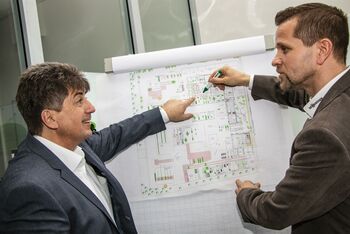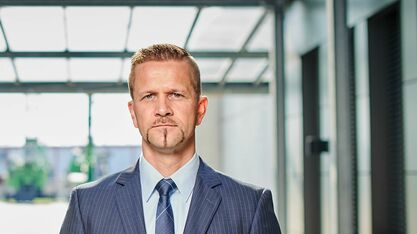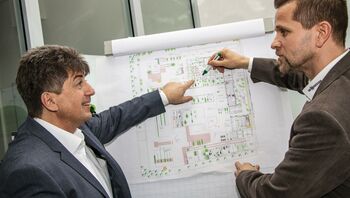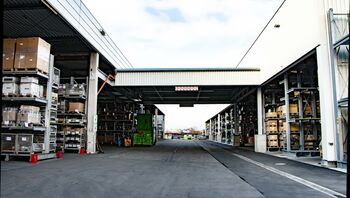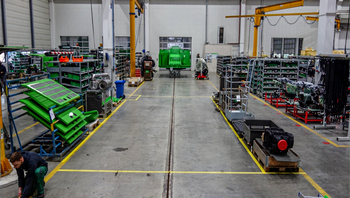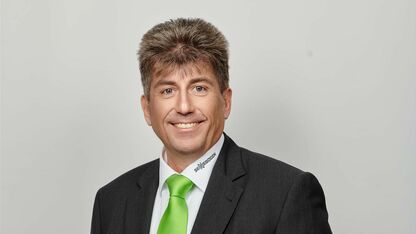Moving large loads - in sync
Or to “Increase efficiency, create more standardization and just get on with it...” This is the motto of Thomas Söldner and Thomas Scheifl, production manager and head of material management respectively at plant 2 in Straubing. A lot has happened here in the last 12 months. The aim is clear - to convert the former belt assembly line to synchronized production.
The aim is clear - to convert the former belt assembly line to synchronized production
“In principle we are undertaking a complete paradigm shift here in plant 2,” explains Thomas Söldner. The previous setup was a sole permanent assembly for the large machines and a belt assembly for the smaller models, that did not run for defined cycles and times.
Also, up to now, one team of technicians worked on the machine almost from start to finish. “That worked well. But we were at the limits of our capacity in terms of logistics and personnel,” explains Söldner. The goal is to produce more machines with a standardized, pull style production, in order to take advantage of the growth opportunities that the market is currently offering.
Thomas Scheifl can already see big opportunities in the efficiency increase for securing future activities. “We have thought this step through well in advance and done a lot of planning for it. Finally, over the past year we boldly attempted to produce a machine here in five phases,” explains Scheifl. It quickly became apparent how important it is to guarantee logistics with precision beforehand.
For this reason, Thomas Scheifl and his material management team have been working intensely on this over the last few months. Whilst the synchronized production is being defined, new logistics concepts have also been developed in parallel and the flow of goods has been analyzed in detail, says Scheifl, explaining the joint approach.
Model plant in Wackersdorf - synchronized assembly and synchronized materials supply now also in Straubing
Whilst the Wackersdorf site has been using synchronized production on the Green Line for a number of years, until now the Straubing plant has specialized in the individual production of large machines and different types of cranes. The plant which opened in 2008 in the industrial area of Straubing’s port is also setup precisely for that. Working closely with colleagues from Wackersdorf, piece by piece the first machines were moved over to the synchronized production system.
For Söldner and Scheifl it was clear: “This can only be done with a good team.” So, a team of experts was soon created that worked with the ongoing production at the same time as the new systems, tests and restructuring. This also includes colleagues from other disciplines, such as quality assurance and purchasing, because, ultimately, everyone needs to be on board with a big project like this.
Thomas Söldner explains what has already been moved over: “In April 2019 we were able to start with the first prototypes in synchronized production, currently we successfully produce the 855 E and 860 E models using the synchronized production system. Other models will follow by the end of the year.”
Results have been seen on the shop floor already. There is more space and the lead times on machines have significantly reduced says Söldner. And thanks to material supply also being synchronized, employees can concentrate fully on their assembly tasks and can be more efficient in the same time period.
Synchronized production and stand assembly of large machine run parallel
“Today, if I want to improve the efficiency of a production line, sooner or later synchronized production comes into play,” Söldner explains clearly. Naturally, it works differently for the big machines, and individual standing assembly will always be required here. In other words, going forward the plant will have two production units. Firstly, the tried-and-tested standing assembly for large and special machines, and secondly, synchronized assembly, which will cover about 75 % of production volume going forward.
Pre-assembly is currently being adapted for the new production system and logistics are being asked to bring the required material to the right location at the right time, says Söldner.
“That is going well,”, addsScheifl. When all is said and done, they have been pulling in the same direction from the start. On the logistics side, storage areas outside of production are being expanded, a new 1000 m² cold storage warehouse is being put into operation for incoming goods, new crane systems are being built and processes are being redeveloped following the analysis of material flows.
“The main focus is to ensure that employees have to hand only the material that they need for the process they are currently doing. This also means that the individual components need to be prepared and pre-assembled so that when the time comes in the synchronized system they can just be put together. In reality this means we will store less material in the assembly areas, but will need to supply more items more often,” summarizes Scheifl.
Great team performance: Improved efficiency, shorter lead times, lean production
“We have already achieved a lot together, a huge amount of respect to the whole team,” says Söldner. “But there is still a lot to do, eventually we want to improve the efficiency of the whole plant, and increase the quantities we produce,” says the production manager, optimistic about the future. Whilst Söldner is keen to move on to synchronizing the next machine type,
Thomas Scheifl is facing another challenge. “We are currently building a tugger train to deliver materials to the assembly areas at the right time. It needs to be planned very accurately as supply bottlenecks will compromise the entire system,” explains the logistics expert. Overall, they have come an awfully long way in just a year. Lead times can be significantly reduced, everything is much more predictable, clear and efficient. Also, potential defects can be identified earlier, and weeded out better and faster during pre-assembly. The whole plant is now on the right track for lean production, on that Scheifl and Söldner are agreed.
But, as they are both keen to emphasize, “It is not just down to the two of us, but the entire team.” A project such as this can only be implemented with input from experts from all departments, the support of experienced colleagues from Wackersdorf and the acceptance and motivation of all the employees. A large part of the work has been done, now the processes need to be transferred over to day-to-day production.
“Success has already proven us right, our plant is cleaner, more clearly structured and, most of all, more efficient. Let’s do it, let’s move big things!”

